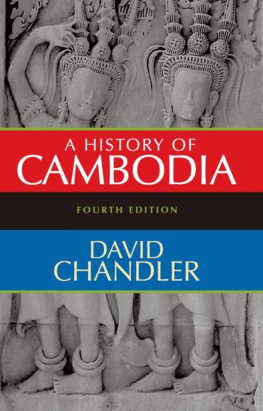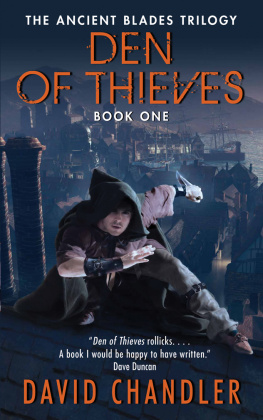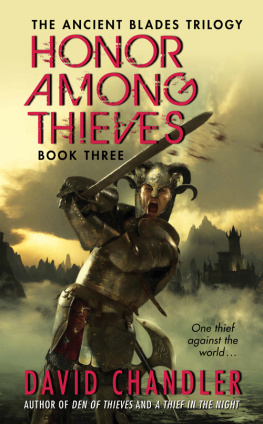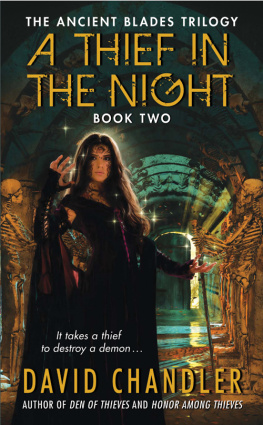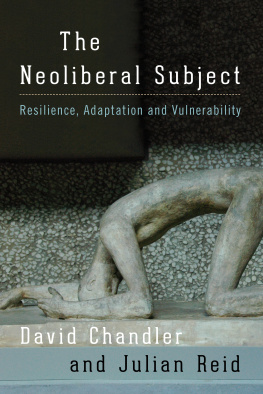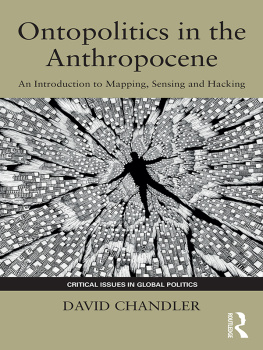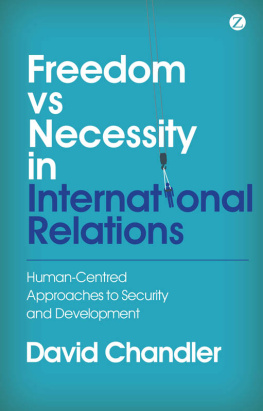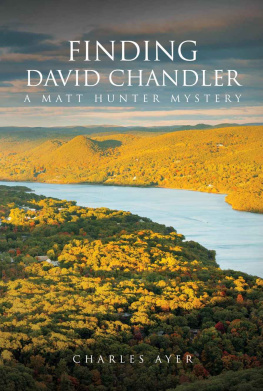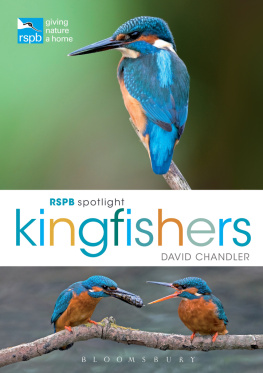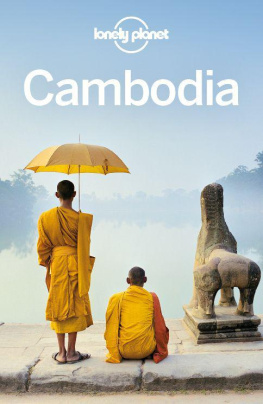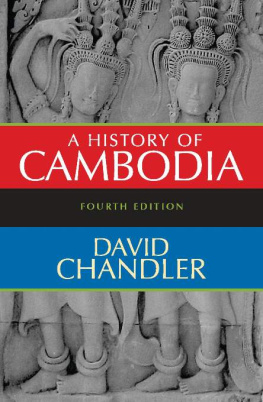David Chandler - A History of Cambodia
Here you can read online David Chandler - A History of Cambodia full text of the book (entire story) in english for free. Download pdf and epub, get meaning, cover and reviews about this ebook. year: 0, genre: History. Description of the work, (preface) as well as reviews are available. Best literature library LitArk.com created for fans of good reading and offers a wide selection of genres:
Romance novel
Science fiction
Adventure
Detective
Science
History
Home and family
Prose
Art
Politics
Computer
Non-fiction
Religion
Business
Children
Humor
Choose a favorite category and find really read worthwhile books. Enjoy immersion in the world of imagination, feel the emotions of the characters or learn something new for yourself, make an fascinating discovery.
- Book:A History of Cambodia
- Author:
- Genre:
- Year:0
- Rating:4 / 5
- Favourites:Add to favourites
- Your mark:
- 80
- 1
- 2
- 3
- 4
- 5
A History of Cambodia: summary, description and annotation
We offer to read an annotation, description, summary or preface (depends on what the author of the book "A History of Cambodia" wrote himself). If you haven't found the necessary information about the book — write in the comments, we will try to find it.
A History of Cambodia — read online for free the complete book (whole text) full work
Below is the text of the book, divided by pages. System saving the place of the last page read, allows you to conveniently read the book "A History of Cambodia" online for free, without having to search again every time where you left off. Put a bookmark, and you can go to the page where you finished reading at any time.
Font size:
Interval:
Bookmark:






DAVID CHANDLER
Alonash University

For Liz, Maggie and Tom

xi
xiii
1 1

Cambodia (map) xvii
A ninth-century statue buried in the forest near Kompong Cham 31
Ninth-century statues abandoned in the forest near Kompong Cham 32
A Cambodian inscription, ninth century CE 38
Guardian spirit, Preah Ko, ninth century 52
A heavenly angel (thevoda) from an eleventh-century temple, Thommanon 59
Angkor War, twelfth-century temple dedicated to Vishnu. The largest religious building in the world, its image has appeared on five successive Cambodian flags since 1953 62
A tower at the Bayon, Jayavarman VII's templemountain, twelfth century CE 67
A twelfth-century bas-relief at the Bayon depicting warfare between Chams and Khmer 75
Reenactment of the Ramayana, Battambang, 1966 109
A rice-growing village in Kompong Speu, 1961 123
Casting a net on the Mekong, 1988, a technique that has remained unchanged for several hundred years 129
Cambodian landscape, 2006 147
Prince Sisowath and his entourage, 1866 169
Entrance to the Royal Palace in Phnom Penh 184
Phnom Penh, aerial view, 1970 202
Cambodian classical dancer, Phnom Penh, 2003 217
Sihanouk dismissed from office; graffito in Phnom Penh, 1970 250
Young girls in revolutionary costume, 1972 253
Zones and administrative divisions of Democratic Kampuchea (map) 259
Democratic Kampuchean cadre, Thai-Cambodian border, 1979 267
Democratic Kampuchean killing ground near Phnom Penh, exhumed in 1979 275
Cambodian woman and Vietnamese soldier, 1980 285
Monks, Siem Reap, 2003 292
Boys on a bridge, Phnom Penh, 2003 299

I'm grateful to Steve Catalano of Westview Press for encouraging me to prepare this edition of a book that was first published in 1983. Mr. Catalano is the latest in a series of talented and helpful editors at Westview who have worked with me on this book. I'm also grateful to Kay Mareia, the project editor, and to Tom Lacey for his assiduous and helpful copyediting. Like the previous editions, this one is dedicated to my children.
The structure and the general approach of the book remain unchanged, but I have revised Chapters 2, 3, 4, and 5 to reflect the valuable research that has been published since the 3rd edition appeared in 2000. I refer especially to the pioneering work of the Greater Angkor Project, Claude Jacques, Christophe Pottier, Ashley Thompson, and Michael Vickery. In the rest of the book I have tried to keep abreast of significant new scholarship. The closing pages, which deal with events since 2000, benefit from several visits to Cambodia and from discussions with many people including Erik Davis, Youk Chhang, Penny Edwards, Kate Frieson, Steve Heder, Don Jameson, John Marston, Un Kheang, and Kim Sedara.
After almost a half-century of being interested in Cambodia, I have contracted many other intellectual debts which it's a pleasure to acknowledge. The deepest ones are to my wife, Susan, who first encouraged me to write this book, and to the late Paul Mus, who inspired my first two years of graduate study. I'm grateful also to my former students Ben Kiernan and John Tully, and to a multitude of colleagues and friends, including Joyce Clark, Christopher Goscha, Anne Hansen, Alexander Hinton, Helen Jessup, Alexandra Kent, Charles Keyes, Judy Ledgerwood, Ian Mabbett, Milton Osborne, Saveros Pon, Lionel Vairon, John Weeks, and Hiram Woodward. The list could be much longer. As Paul Mus has tellingly written, "People build themselves out of what is brought to them by friends."
In 2005 the third edition was ably translated into Khmer under the auspices of the Center for Khmer Studies. The interest that the translation aroused among Cambodians has been very gratifying to me, and I hope that some of the men and women who read the translation will become historians of Cambodia themselves.
Finally, these lines provide a sad but suitable occasion for me to mourn the recent loss of five amiable and talented coznpagnons de route: May Ebihara, Richard Melville, Ingrid Muan, Jacques Nepote, and David Wyatt. I miss their friendship, their company, and their insights into Cambodia's history and culture.
Melbourne, Australia
February 2007
David Chandler



This book will examine roughly two thousand years of Cambodian history. Chapters 2 through 5 carry the story up to the end of the eighteenth century; the remaining chapters deal with the period between 1794 and 2007.
One reason for writing the book has been to close a gap in the historiography of Southeast Asia. No lengthy history of Cambodia has appeared since the publication of Adhemard Leclere's Histoire du Cambodge in 1914.' Subsequent surveys, in French and English, have limited themselves to the study of particular eras or have relied primarily on secondary sources.2 Over the last sixty years or so, moreover, many of Leclere's hypotheses and much of his periodization-to say nothing of his style of approach-have been revised by other scholars, weakened by new documents, or altered by archaeological findings. The colonial era ended in 1953 and needs examination in terms of preceding history; moreover, the so-called middle period discussed in Chapters 5 through 7 has often been ignored even though it clearly forms a bridge between Angkor and the present.
The time has come, in other words, to reexamine primary sources, to synthesize other people's scholarly work, and to place my own research, concerned mainly with the nineteenth and twentieth centuries, into the framework of a general history, with a nonspecialist audience, as well as undergraduates, in mind.
As it stands the book examines several themes. One of these has to do with the effects on Cambodian politics and society of the country's location between Thailand and Vietnam. This theme, which is discussed in detail in Chapters 6 and 7, has been crucial since the second half of the eighteenth century and has recently faded in importance. For over two hundred years, beginning in the 1780s, the presence of two powerful, antagonistic neighbors forced the contentious Cambodian elite either to prefer one or the other or to attempt to neutralize them by appealing to an outside power. Cambodian kings tried both alternatives in the nineteenth century. Later on, Norodom Sihanouk, Lon Nol, and Pol Pot all attempted the second; the regime of the State of Cambodia (SOC), formerly the People's Republic of Kampuchea, which lasted from 1979 until 1991, committed itself to the patronage of Vietnam. A UN protectorate (1991-93) neutralized the contending foreign patrons of Cambodia by removing it from Cold War rivalries. In the late 1990s Cambodia and Vietnam joined the Association of Southeast Asian Nations (ASEAN), and the Kingdom of Cambodia, established under that name in 1993, has so far avoided seeking a dominant foreign patron, although in recent years China has emerged as an increasingly important ally and benefactor of the regime.
Font size:
Interval:
Bookmark:
Similar books «A History of Cambodia»
Look at similar books to A History of Cambodia. We have selected literature similar in name and meaning in the hope of providing readers with more options to find new, interesting, not yet read works.
Discussion, reviews of the book A History of Cambodia and just readers' own opinions. Leave your comments, write what you think about the work, its meaning or the main characters. Specify what exactly you liked and what you didn't like, and why you think so.

